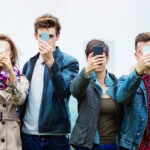Illnesses with the millennial designation of origin
Tired eyes, hands and mind? Slave to your smartphone and a compulsive ‘selfie-taker? Young people are the ones that suffer the most from techno-addictions and the new ailments of the 21st century.

Three hours a day. It is the average time that young people spend diving in the digital sea, according to studies carried out by Nominalia and TNS. A recent PISA report found that 22% of Spanish teens are extreme Internet users, spending up to six hours online a day. Younger generations keep spending more and more time hooked on to their smartphones. But, what content do they consume and on what devices? And, more importantly, what diseases and addictions is this generation suffering?
First off, a selfie
The Greek myth of Narcissus has come to life in many users of social media such as Instagram or Snapchat and their ephemeral publications. The appetite for preserving memories and the lack of restraint when exhibiting every aspect of one’s private life seem to be factors that have led to this addiction. However, psychologist Jonathan García-Allen in an article in 'Psicología y Mente', a psychology journal, argues that "selfies are a consequence of the culture and the socio-economic system in which we live. We have been educated to consume aesthetics, leisure and entertainment because they are axial elements of a society that tends to alienate people and to standardize certain criteria about beauty and fun," although, he adds "the main problem is not new technologies, but the pathological use of them.”
Addicted or not, selfies are an intrinsic part of Generation Y’s lifestyle. Unsurprisingly, Fundéu, a non-profit organization that defends the unity and purity of the Spanish language, chose ‘selfi’, Spanish for selfie, as word of the year back in 2014. And to take the best pictures, there are plenty of add-ons in the market. While the term ‘monopod’ may mean nothing to many, its synonym, 'selfie stick', is sure to summon images of the Tower of Pisa or the Niagara Falls tarnished by dozens of metallic colored sticks. Other 'wearables' include smartphone lenses that allow taking a wider variety of shots, including 'fisheye' or 'wide angle' shots; 360º rotation tripods, perfect for taking the best landscape pictures; and even mobile phone cases with built-in flash and lens.
The health hazards of the techno-addicted
The pace of technological and social progress has increased exponentially in recent years, and young people have been quick to harness the potential of not only digital devices for photography, but of the digital era at large. Health, economic and cultural problems are the other side of the coin. Some of these downsides, although not entirely exclusive to this generation, have been aggravated by this 'stage 2.0':
- Nomophobia. This pathology is perhaps the most typically millennial. The Anglicism refers to the fear, anxiety and obsession some individuals suffer when they're without their smartphone or internet connection. Hyperconnectivity and information addiction is more common among younger people, some of which can spend more than seven hours a day connected.
- Permanent consumerism. The pursuit of instant gratification, novelty, and sharing experiences have spawned a 'Whenever Whatever & Wherever I Want' mindset, which translates into immediate purchases through mobile devices. While it may seem like an advantage for brands, they are still trying to figure out how to reach out to millennials, which make decisions most impulsively.
- Visual fatigue, dry eye syndrome, and other eye conditions are a result, to a large extent, of the amount of hours that individuals spend staring at a screen. What other parts of the body may be affected by the excessive use of these virtual devices? Incredible as it may seem, intensive use of virtual keyboards can induce a variety of strain injuries affecting thumbs, wrists and hands.
- Dysthymia. This is the largely unknown medical term for a much more famous condition: Depression. Specifically, a mild but chronic form of depression. This mood disorder may be hard to detect, especially in children and teenagers, but can cripple the professional and social life of those that suffer it. What can trigger it? Anything from a 'sold out' banner to their favorite 'youtuber' failing to post his/her weekly video.
The main problem is not new technologies, but the pathological use of them” García Allen
When fandom becomes an obsession
For some psychologists, such as José Félix Rodríguez, that the 'fan phenomena' among younger people and teenagers should not be a cause for concern, since they correspond to group movements and the sense of belonging. However, Rodríguez stresses that "certain people fail to establish this identity and may end-up spiraling into unhealthy personality worship disorders." Some examples could be the criticism that targets some 'influencers' for their lifestyle. Even though they have a team of people behind and work long hours, they are not safe from haters, and fan harassment has forced some of these influencers to move houses. Even fashion brands have come to rebel against this phenomenon in their designs.
However, the feeling of admiration towards celebrities can have some positive effects that should not be overlooked, because "belonging to a group of fans helps teens to connect with other like-minded people on social networks throughout the year, as well as in events and concerts, “says Professor Laurel Steinberg.